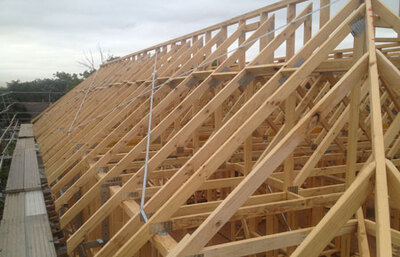Timber Frame Construction: A Sustainable and Durable Building Solution
Timber frame construction has been a popular building method for centuries due to its strength, durability, and aesthetic appeal. With a focus on sustainability and energy efficiency, timber frame construction has seen a resurgence in modern architecture. This method uses a framework of large wooden beams to form a solid structure, offering an eco-friendly alternative to traditional building techniques.
In this article, we explore the benefits, construction process, and key considerations when choosing timber frame construction for residential and commercial projects.
What is Timber Frame Construction?
Timber frame construction is a building technique that uses heavy timber posts and beams to create a strong structural framework. Unlike conventional wood-framed buildings that rely on smaller studs, this method involves precisely cut wooden joints, reducing the need for metal fasteners and nails.
Key Features of Timber Frame Construction:
Eco-Friendly Materials: Sustainable wood sources minimize environmental impact.
Energy Efficiency: Superior insulation and airtight design reduce heating and cooling costs.
Durability and Strength: Large timber beams provide exceptional load-bearing capacity.
Aesthetic Appeal: Exposed wooden beams add a rustic, natural charm.
Quick Construction Time: Prefabricated components speed up the building process.
Benefits of Timber Frame Construction
1. Sustainability and Environmental Benefits
Timber is a renewable resource that absorbs carbon dioxide, making it one of the most eco-friendly building materials. Many timber suppliers follow sustainable forestry practices, ensuring minimal impact on the environment.
2. Energy Efficiency and Insulation
Timber frame structures are well-insulated, reducing energy loss and lowering utility bills. The airtight nature of these buildings helps maintain consistent indoor temperatures year-round.
3. Structural Strength and Longevity
Due to the robustness of timber, these structures can last for centuries when properly maintained. Timber frame buildings withstand extreme weather conditions, making them ideal for various climates.
4. Speed of Construction
Prefabricated timber frames allow for faster assembly compared to traditional construction methods. This reduces labor costs and minimizes project delays.
5. Aesthetic and Design Flexibility
Timber frame construction allows for open floor plans with fewer load-bearing walls. The natural beauty of exposed wood creates a warm, inviting atmosphere, making it popular for residential homes, lodges, and commercial spaces.
How Timber Frame Construction Works
Step 1: Design and Planning
Architects and engineers design the timber frame structure based on client preferences and building codes.
Wood selection includes durable Timber Truss like oak, Douglas fir, or pine.
Step 2: Timber Preparation
Wood is precisely cut, shaped, and treated for durability.
Joints are crafted to fit seamlessly without excessive metal fasteners.
Step 3: Frame Assembly
Prefabricated beams are transported to the construction site and assembled using traditional joinery techniques.
The main structure is erected in a short time, reducing overall build duration.
Step 4: Insulation and Finishing
High-quality insulation is installed to enhance energy efficiency.
Roof, windows, and doors are added to complete the building.
FAQ: Timber Frame Construction
Q1: Is timber frame construction more expensive than traditional methods? A: While the upfront cost may be higher, timber frame buildings offer long-term savings through energy efficiency and reduced maintenance.
Q2: How long does a timber frame building last? A: With proper maintenance, timber frame structures can last for several centuries.
Q3: Can timber frame homes be customized? A: Yes! Timber frame designs are highly flexible, allowing for various architectural styles and interior layouts.
Q4: Are timber frame buildings resistant to fire? A: Surprisingly, timber burns at a slower rate than steel, maintaining its structural integrity longer in a fire.
Q5: Is timber frame construction suitable for commercial buildings? A: Absolutely! Many commercial structures, including offices, hotels, and community centers, use timber frame construction due to its durability and aesthetic appeal.
Testimonial
Sarah L., Homeowner: "We chose timber frame construction for our dream home, and it was the best decision! The warmth and beauty of exposed wood create an inviting space, and the insulation keeps our energy costs low. The craftsmanship and sustainability make timber frames a fantastic choice for anyone looking to build a durable, eco-friendly home."
Conclusion
Timber frame construction offers a sustainable, energy-efficient, and visually stunning alternative to conventional building methods. Whether you're constructing a residential home, a commercial building, or a community space, timber frames provide long-lasting strength and aesthetic appeal. By investing in timber frame construction, you benefit from an environmentally friendly and cost-effective solution that stands the test of time. Explore your options today and bring your architectural vision to life!





Comments
Post a Comment